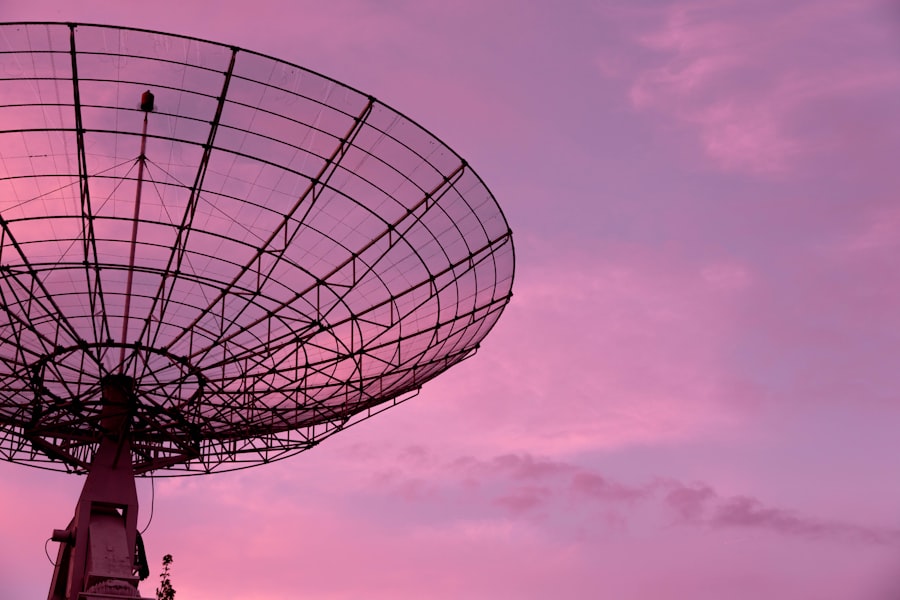International space satellites play a pivotal role in the exploration of the universe, serving as the eyes and ears of humanity beyond our planet. These sophisticated instruments are designed to observe celestial phenomena, gather data, and transmit valuable information back to Earth. By utilizing advanced technology, satellites can monitor everything from the cosmic microwave background radiation to the intricate details of distant galaxies.
The data collected by these satellites not only enhances our understanding of the universe but also aids in answering fundamental questions about its origins, structure, and eventual fate. The collaborative nature of international space missions has significantly amplified the capabilities of these satellites. For instance, the Hubble Space Telescope, a joint project between NASA and the European Space Agency (ESA), has provided breathtaking images and critical data that have reshaped our understanding of the cosmos.
Hubble’s observations have led to groundbreaking discoveries, such as the acceleration of the universe’s expansion and the existence of exoplanets. This collaboration exemplifies how pooling resources and expertise from different countries can lead to monumental advancements in space exploration.
Key Takeaways
- International space satellites play a crucial role in exploring the universe by providing valuable data and imagery from distant celestial bodies.
- Collaborative efforts among different countries and space agencies have led to significant advancements in space exploration, allowing for shared resources and expertise.
- Advancements in satellite technology, such as improved sensors and communication systems, have enhanced the capabilities of international space satellites for exploring the universe.
- International space satellites gather data from the universe through various methods, including remote sensing, spectroscopy, and imaging, to study celestial objects and phenomena.
- International space satellites have had a significant impact on scientific discoveries, contributing to our understanding of the universe and expanding our knowledge of space.
Collaborative Efforts in Space Exploration
Collaboration in space exploration is not merely a trend; it is a necessity driven by the complexity and cost of modern space missions. Countries around the globe recognize that pooling their resources, knowledge, and technology can yield far greater results than working in isolation. The International Space Station (ISS) stands as a testament to this collaborative spirit, involving contributions from multiple nations including the United States, Russia, Japan, Canada, and various European countries.
The ISS serves as a microgravity laboratory where scientists conduct experiments that would be impossible on Earth, furthering our understanding of biology, physics, and materials science. Moreover, international partnerships extend beyond human spaceflight. The Mars Exploration Program is another prime example of collaboration, with various nations contributing to missions aimed at exploring the Red Planet.
NASA’s Perseverance rover, which landed on Mars in February 2021, carries instruments developed by international partners, including a weather station from Spain and a helicopter drone from France. Such collaborations not only enhance mission capabilities but also foster goodwill among nations, promoting peaceful uses of outer space.
Advancements in Satellite Technology for Space Exploration

The evolution of satellite technology has been nothing short of revolutionary in the context of space exploration. Early satellites were relatively simple devices with limited capabilities, primarily designed for communication or basic Earth observation. However, advancements in materials science, miniaturization, and data processing have led to the development of highly sophisticated satellites capable of performing complex tasks.
For instance, modern satellites are equipped with high-resolution cameras and spectrometers that can analyze light from distant stars and galaxies, providing insights into their composition and behavior. One notable advancement is the emergence of CubeSats—small, modular satellites that can be deployed in swarms to gather data over large areas or specific targets. These compact satellites are cost-effective and can be launched in groups aboard larger rockets, allowing for extensive coverage of celestial phenomena.
The Planetary Society’s LightSail mission is an example of how CubeSats can be utilized for innovative exploration techniques, such as solar sailing. This technology harnesses sunlight for propulsion, potentially enabling long-duration missions to distant destinations without relying on traditional fuel sources.
How International Space Satellites Gather Data from the Universe
| Data Source | Method | Examples |
|---|---|---|
| Telescopes | Collecting light from distant objects | Hubble Space Telescope, James Webb Space Telescope |
| Radar | Using radio waves to map surfaces | Magellan spacecraft, Arecibo Observatory |
| Particle Detectors | Measuring cosmic rays and particles | Alpha Magnetic Spectrometer, Voyager spacecraft |
| Space Probes | Directly studying planets and moons | Cassini-Huygens, Mars rovers |
International space satellites employ a variety of sophisticated instruments to gather data from the universe. These instruments are designed to detect different types of electromagnetic radiation, including visible light, infrared, ultraviolet, and radio waves. For example, the Chandra X-ray Observatory specializes in capturing X-ray emissions from high-energy regions of space, such as black holes and supernova remnants.
By analyzing these emissions, scientists can gain insights into extreme physical processes that occur in the universe. In addition to direct observation, satellites often utilize advanced techniques such as spectroscopy to analyze the light emitted or absorbed by celestial objects. This method allows researchers to determine the chemical composition, temperature, density, and motion of stars and galaxies.
The European Space Agency’s Gaia mission exemplifies this approach; it aims to create a three-dimensional map of our galaxy by measuring the positions and movements of over a billion stars. Such detailed mapping not only enhances our understanding of stellar evolution but also provides clues about the structure and dynamics of the Milky Way.
International Space Satellites and their Impact on Scientific Discoveries
The impact of international space satellites on scientific discoveries cannot be overstated. These instruments have fundamentally altered our understanding of astrophysics, cosmology, and planetary science. For instance, data from the Kepler Space Telescope has led to the discovery of thousands of exoplanets—planets orbiting stars outside our solar system—thereby expanding our knowledge of potential habitable worlds beyond Earth.
This has profound implications for astrobiology and our search for extraterrestrial life. Furthermore, international collaborations have facilitated groundbreaking discoveries that would have been impossible without shared expertise and resources. The Event Horizon Telescope (EHT), a global network of radio telescopes, successfully captured the first image of a black hole in 2019.
This monumental achievement was made possible through contributions from scientists across multiple countries working together to synchronize observations from various locations around the world. Such collaborative efforts not only advance scientific knowledge but also inspire future generations to pursue careers in science and technology.
The Future of International Space Satellites in Exploring the Universe

Looking ahead, the future of international space satellites appears promising as technological advancements continue to unfold. Upcoming missions are set to push the boundaries of exploration even further. For instance, NASA’s James Webb Space Telescope (JWST), scheduled for launch in late 2021, aims to observe the universe’s first galaxies and study the atmospheres of exoplanets in unprecedented detail.
This mission represents a significant leap forward in our ability to explore cosmic history and assess conditions for life beyond Earth. Moreover, international partnerships are likely to expand as more countries develop their own space programs. Nations such as India and China are making significant strides in satellite technology and space exploration capabilities.
Collaborative missions involving emerging spacefaring nations could lead to innovative approaches to exploring distant celestial bodies or even crewed missions to Mars. As more countries join forces in space exploration endeavors, we can expect a richer tapestry of scientific discovery that reflects diverse perspectives and expertise.
Challenges and Limitations of International Space Satellites in Space Exploration
Despite their remarkable capabilities, international space satellites face numerous challenges and limitations that can hinder their effectiveness in exploring the universe. One significant challenge is the vastness of space itself; even with advanced technology, gathering comprehensive data over immense distances remains a daunting task. For example, while telescopes like Hubble have provided invaluable insights into distant galaxies, they can only observe a fraction of what exists beyond our observable universe.
Additionally, budget constraints often limit the scope and duration of satellite missions. Developing and launching sophisticated satellites requires substantial financial investment, which can be difficult for many countries to sustain over time. This limitation can lead to compromises in mission objectives or delays in launching new projects.
Furthermore, international collaborations may face bureaucratic hurdles or differing priorities among partner nations that can complicate mission planning and execution.
International Space Satellites and their Contributions to Understanding the Universe
International space satellites have made profound contributions to our understanding of the universe by providing critical data that informs scientific theories and models. For instance, observations from various satellites have helped refine our understanding of dark matter and dark energy—two mysterious components that make up most of the universe’s mass-energy content yet remain poorly understood. The Planck satellite’s measurements of cosmic microwave background radiation have provided insights into the early universe’s conditions and supported models of cosmic inflation.
Moreover, these satellites have played a crucial role in advancing our knowledge about planetary systems within our own solar system. Missions like NASA’s Voyager probes have traveled beyond the outer planets, sending back invaluable data about their atmospheres, magnetic fields, and potential for hosting life. Such discoveries not only enhance our understanding of our solar system but also inform future exploration efforts aimed at uncovering the mysteries of other planetary systems throughout the galaxy.
In summary, international space satellites are indispensable tools for exploring the universe. Their collaborative nature fosters innovation and discovery while advancing our understanding of fundamental cosmic questions. As technology continues to evolve and more nations engage in space exploration efforts, we can anticipate an exciting future filled with new revelations about our universe’s vastness and complexity.


